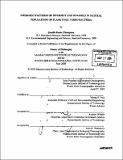| dc.contributor.advisor | Martin F. Polz. | en_US |
| dc.contributor.author | Thompson, Janelle Renée, 1976- | en_US |
| dc.contributor.other | Woods Hole Oceanographic Institution. | en_US |
| dc.date.accessioned | 2007-10-22T18:32:02Z | |
| dc.date.available | 2007-10-22T18:32:02Z | |
| dc.date.copyright | 2005 | en_US |
| dc.date.issued | 2005 | en_US |
| dc.identifier.uri | http://hdl.handle.net/1721.1/39404 | |
| dc.description | Thesis (Ph. D.)--Joint Program in Biological Oceanography (Massachusetts Institute of Technology, Dept. of Civil and Environmental Engineering; and, the Woods Hole Oceanographic Institution), 2005. | en_US |
| dc.description | This electronic version was submitted by the student author. The certified thesis is available in the Institute Archives and Special Collections. | en_US |
| dc.description | Includes bibliographical references. | en_US |
| dc.description.abstract | Despite the importance of microorganisms for global and engineering processes, currently lacking is a theoretical framework to describe how the structure of a microbial assemblage translates an environmental condition into a system-level response. Prerequisite to developing such a framework is an understanding of how microbial diversity is partitioned into functional groups of organisms. This thesis has explored the organization and dynamics of microbial diversity within coastal bacterioplankton using the genus Vibrio as a model system. Vibrios are ubiquitous marine bacteria, and include a variety of pathogens. Quantification of Vibrio environmental dynamics by cultivation- independent quantitative PCR and constant denaturant capillary electrophoresis (CDCE), suggests that sea surface temperature is a driving factor in the distribution and abundance of Vibrio populations and that groups of organisms with >98-99% 16S rRNA sequence similarity maintain similar responses to temperature-mediated environmental change. Fine-scale analysis of the genetic structure within one Vibrio population (>99% rRNA similarity to V. splendidus) reveals vast co-occurring genomic diversity. The average concentration of unique genome-types is observed to be 1000-fold lower than the total population size and individual genomes vary in gene content by as much as 1.1 Mb (the equivalent of -1,000 genes). It is proposed that competition between individual genome variants is a weak driver of population genetic structure while stochastic interactions in the water column promote genetic heterogeneity rendering much of the observed diversity in natural populations neutral or effectively neutral. | en_US |
| dc.description.abstract | (cont.) Quantification of Vibrio diversity and dynamics is critical to understanding the global factors that determine the prevalence and proliferation of disease-causing strains and their potential contribution to ecosystem-level processes such as organic matter degradation and macronutrient cycling. In addition, an understanding of how diversity is organized in natural assemblages is an important step in the effort to predict the characteristics of microbial systems based upon their component populations. | en_US |
| dc.description.statementofresponsibility | by Janelle Renée Thompson. | en_US |
| dc.format.extent | 164 p. | en_US |
| dc.language.iso | eng | en_US |
| dc.publisher | Massachusetts Institute of Technology | en_US |
| dc.rights | M.I.T. theses are protected by copyright. They may be viewed from this source for any purpose, but reproduction or distribution in any format is prohibited without written permission. See provided URL for inquiries about permission. | en_US |
| dc.rights.uri | http://dspace.mit.edu/handle/1721.1/7582 | |
| dc.subject | Joint Program in Biological Oceanography. | en_US |
| dc.subject | Civil and Environmental Engineering. | en_US |
| dc.subject | Woods Hole Oceanographic Institution. | en_US |
| dc.title | Emergent patterns of diversity and dynamics in natural populations of planktonic Vibrio bacteria | en_US |
| dc.type | Thesis | en_US |
| dc.description.degree | Ph.D. | en_US |
| dc.contributor.department | Joint Program in Biological Oceanography. | en_US |
| dc.contributor.department | Woods Hole Oceanographic Institution | en_US |
| dc.contributor.department | Massachusetts Institute of Technology. Department of Civil and Environmental Engineering | |
| dc.identifier.oclc | 61171429 | en_US |
